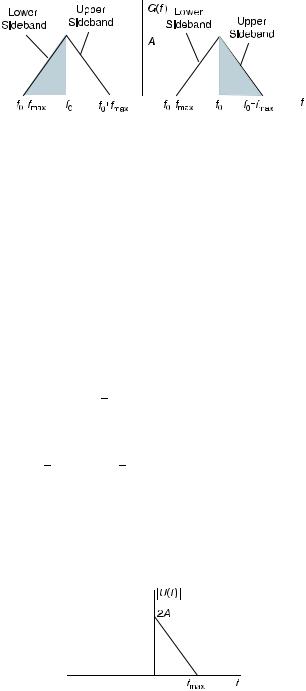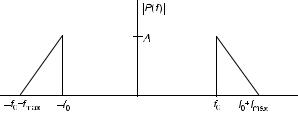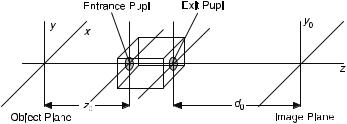
Ersoy O.K. Diffraction, Fourier optics, and imaging (Wiley, 2006)(ISBN 0471238163)(427s) PEo
.pdf

ANALYTIC SIGNAL |
159 |
Figure 10.1. The spectrum of a lowpass signal.
It is observed that the analytic signal has twice the energy of the corresponding real signal.
EXAMPLE 10.6 The amplitude spectrum of a lowpass signal uðtÞ is shown in Figure 10.1.
It is modulated by cosð2pf0tÞ to generate gðtÞ ¼ uðtÞ cosð2pf0tÞ. (a) Find and draw the amplitude spectrum of gðtÞ, and (b) Draw the amplitude spectrum of the analytic signal generated from uðtÞ, and (c) Find and draw the amplitude spectrum of pðtÞ ¼ uðtÞ cosð2pf0tÞ vðtÞ sinð2pf0tÞ.
Solution:
(a) gðtÞ can be written as
g t |
Þ ¼ |
uðtÞ |
e j2pf0t |
þ |
uðtÞ |
e j2pf0t |
|
ð |
10:3-14 |
Þ |
||||||
ð |
2 |
|
|
2 |
|
|
|
|||||||||
The FT of gðtÞ is given by |
|
|
|
|
|
|
|
|
|
|
|
|
|
|
|
|
Gð f Þ ¼ |
1 |
Uð f f0 |
Þ þ |
1 |
Uð f þ f0 |
Þ |
ð10:3-15Þ |
|||||||||
|
|
|
|
|||||||||||||
2 |
2 |
|||||||||||||||
The amplitude spectrum is given by |
|
|
|
|
|
|
|
|
|
|
||||||
|
|
1 |
jUð f f0Þ þ Uð f þ f0Þj |
|
|
|
||||||||||
jGð f Þj ¼ |
|
ð10:3-16Þ |
||||||||||||||
2 |
||||||||||||||||
jGð f Þj is shown in Figure 10.2. |
|
|
|
|
|
|
|
|
|
|
|
|
and f0 fmax |
|||
The frequency components in the range f0 f f0 þ fmax |
||||||||||||||||
f f0 are known as the upper sideband. The frequency components in the range
f0 f f0 þ fmax and f0 fmax f f0 are known as the lower sideband.
(b) The analytic signal generated from u(t) is given by
sðtÞ ¼ uðtÞ þ jvðtÞ |
ð10:3-17Þ |




DIFFRACTION EFFECTS IN A GENERAL IMAGING SYSTEM |
163 |
||||||
|
|
|
|
|
|
|
|
|
|
|
|
|
|
|
|
|
|
|
|
|
|
|
|
|
|
|
|
|
|
|
|
Figure 10.5. Model of an optical imaging system.
systems as well as to quasi-monochromatic sources with spatially coherent and spatially incoherent illumination.
A general imaging system typically consists of a number of lenses. Such an imaging system can be characterized in terms of an entrance pupil and an exit pupil, which are actually both images of an effective system aperture [Goodman]. This is shown in Figure 10.5. Diffraction effects can be expressed in terms of the exit pupil and the distance d0 between the exit pupil and the image plane.
An optical system is called diffraction limited if a diverging spherical wave incident on the entrance pupil is mapped into a converging spherical wave at the exit pupil. For a real imaging system, this property is at best limited to finite areas of object and image planes. Aberrations are distortions modifying the spherical property. They are discussed in Section 10.9.
In a general imaging system with many lenses, Eqs. (9.4-17) and (9.4-18) remain valid provided that P(.,.) denotes the finite equivalent exit pupil of the system, the equivalent focal length of the system and the distance from the exit pupil to the image plane is used, and the system is diffraction limited [Goodman].
We define the ideal image appearing in Eq. (8.4-17) as |
|
||||
|
x |
|
y |
|
|
Ugðx; yÞ ¼ U |
|
; |
|
|
ð10:6-1Þ |
M |
M |
||||
where Uðx; yÞ is the original image (wave field). Equation (9.4-16) is rewritten as
|
1 |
1 |
|
|
|
|
Uðx0; y0Þ ¼ |
ð |
ð |
hðx0 x; y0 yÞUgðx; yÞdxdy |
ð10:6-2Þ |
||
|
1 1 |
|
|
|
|
|
where |
|
|
|
|
|
|
|
1 |
1 |
|
|
|
|
hðx; yÞ ¼ |
ð |
ð |
Pðx1; y1Þe j |
2p |
ðxx0þyy0Þdxdy |
ð10:6-3Þ |
ld0 |
||||||
|
1 1 |
|
|
|
|
|

164 |
IMAGING WITH QUASI-MONOCHROMATIC WAVES |
10.7IMAGING WITH QUASI-MONOCHROMATIC WAVES
In practical imaging systems, the conditions for quasi-monochromatic wave fields are usually satisfied. For example, in ordinary photography, films are sensitive to the visible range of the electromagnetic temporal spectrum. Then, it can be shown that the complex envelope of the analytic signal satisfies the imaging equations derived previously. Thus, Eq. (10.6-2) can be written as
UAðx0; y0; d0; tÞ ¼ hðx0; y0Þ UGðx0; y0; t tÞ
¼ |
ðð |
hðx0 x; y0 yÞUGðx; y; t tÞdxdy ð10:7-1Þ |
|
1 |
|
|
1 |
|
where hðx0; y0Þ is given by Eq. (10.6-3) except that l is replaced by lc, and UGðx0; y0; tÞ is the complex envelope of the analytic signal corresponding to the ideal image Uð xM0 ; yM0 ; tÞ predicted by geometrical optics; t is a time delay associated with propagation to the image plane.
The amplitude transfer function Hðfx; yyÞ is the FT of hðx; yÞ:
Hð fx; fyÞ ¼ Pðld0 fx; ld0 fyÞ |
ð10:7-2Þ |
Detector systems are sensitive to intensity of the wave field, which can be written as
Iðx0; y0; d0Þ ¼ hjUAðx0; y0; d0; tÞj2i |
ð10:7-3Þ |
where h i indicates an infinite time average. Using Eq. (10.7.1), Iðx0; y0; d0Þ can be written as
Iðx0; y0; d0Þ |
ðð |
|
ðð |
||
1 |
1 |
|
¼hðx0 x; y0 yÞ h ðx0 x0; y0 y0ÞIGðx; y; x0; y0Þdx0dy0 dxdy
1 |
1 |
ð10:7-4Þ |
|
|
|
where |
|
|
|
IGðx; y; x0; y0Þ ¼ hUGðx; y; t t1ÞUGðx0; y0; t t2Þi |
ð10:7-5Þ |
IG is known as the mutual intensity. In Eq. (10.7-5), t1 and t2 are approximately equal because the impulse response h is limited to a small region around the image point and hence can be neglected.

IMAGING WITH QUASI-MONOCHROMATIC WAVES |
165 |
10.7.1Coherent Imaging
For perfectly coherent wave fields, we can write
UGðx; y; tÞ ¼ UGðx; yÞUGð0; 0; tÞ |
ð10:7:1-1Þ |
where UGðx; yÞ is the phasor amplitude of UGðx; y; tÞ relative to the wave field at the origin.
We write
|
|
hUGðx; y; tÞUGðx; y; tÞi ¼ KUGðx; yÞUGðx0; y0Þ |
ð10:7:1-2Þ |
where the constant K is given by |
|
||
|
|
K ¼ hjUGð0; 0; tÞj2i |
ð10:7:1-3Þ |
Neglecting K, the intensity is written as |
|
||
|
|
Iðx0; y0; d0Þ ¼ jU1ðx0; y0Þj2 |
ð10:7:1-4Þ |
where |
|
; y0Þ ¼ hðx0; y0Þ UGðx0; y0Þ ¼ ðð hðx0 x; y0 yÞUGðx; yÞdxdy |
|
U1 |
ðx0 |
||
|
|
1 |
|
1
ð10:7:1-5Þ
Thus, the coherent imaging system is linear in complex amplitude of the analytic signal relative to the origin.
EXAMPLE 10.7 Determine the cutoff frequency of a diffraction-limited coherent imaging system with a circular effective pupil of radius R, assuming that the image forms at a distance d0 from the system.
Solution: The pupil function in this case is given by
p!
x2 þ y2
Pðx; yÞ ¼ circ
R
The amplitude transfer function is given by
H fx; fy |
P ld0fx; ld0fy |
|
circ |
|
q |
|
|
|
|
|
|
@ |
fx2 þ fy2 |
A |
|
|
|
|
|
l |
0 |
||
ð |
Þ ¼ ð |
Þ ¼ |
|
0 |
R= d |
|
1 |


FREQUENCY RESPONSE OF A DIFFRACTION-LIMITED IMAGING SYSTEM |
167 |
where Hð fx; fyÞ is the 2-D FT of the impulse response:
Hð fx; fyÞ ¼ |
ðð |
hðx; yÞe j2pð fxxþfyyÞdxdy ¼ Pðld0 fx; ld0 fyÞ |
ð10:8:1-2Þ |
|
1 |
|
|
1
Hð fx; fyÞ is known as the coherent transfer function.
It is observed that a coherent imaging system is equivalent to an ideal low-pass filter, which passes all frequencies within the pupil function’s ‘‘1’’ zone and cuts off all frequencies outside this zone.
10.8.2Incoherent Imaging System
Incoherent imaging systems are linear in intensity. The visual quality of an image is largely determined by the contrast of the relative intensity of the informationbearing details of the image to the ever-present background. The output image and the input ideal image can be normalized by the total image energy to reflect this property:
I0ðx0 |
; y0; d0 |
Þ ¼ |
1 |
Iðx0; y0; d0Þ |
|
|
|
|
|||||
|
|
|
ðð Iðx0; y0; d0Þdx0dy0 |
|||
|
|
1 |
ð10:8:2-1Þ |
|||
|
IG0 ðx; yÞ ¼ |
1 |
IGðx; yÞ |
|
||
|
|
|||||
|
|
|
ðð IGðx; yÞdxdy |
|||
|
|
1 |
|
|
|
|
Let us denote the 2-D FT of I0ðx0; y0; d0Þ and IG0 ðx; yÞ by Jð fx; fyÞ and JGð fx; fyÞ, respectively. By convolution theorem, Eq. (10.7.2-2) can be written as
Jð fx; fyÞ ¼ HI ð fx; fyÞJGð fx; fyÞ |
ð10:8:2-2Þ |
|||
where |
ðð |
jhðx; yÞj2e j2pð fxxþfyyÞ |
|
|
|
|
|||
|
1 |
|
|
|
HI ð fx; fyÞ ¼ |
1 1 |
dxdy |
ð10:8:2-3Þ |
|
|
|
ðð |
jhðx; yÞj2dxdy |
|
|
|
1 |
|
|
HI ð fx; fyÞ is called the optical transfer function (OTF). The modulation transfer function (MTF) is defined as jHI ð fx; fyÞj.

 Linear System
Linear System Actual Image
Actual Image